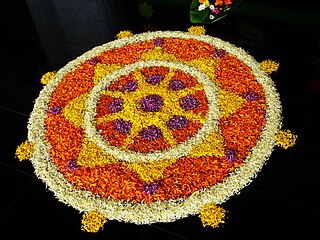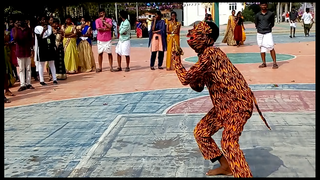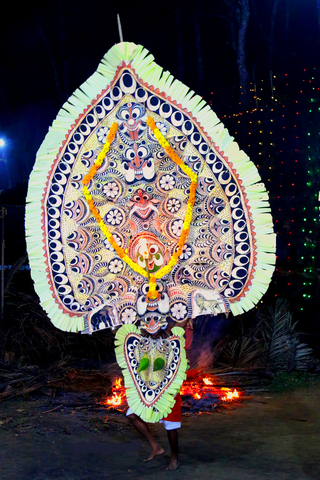
Thrissur, formerly Trichur, also known by its historical name Thrissivaperur, is a city and the headquarters of the Thrissur district in Kerala, India. It is the third largest urban agglomeration in Kerala after Kochi and Kozhikode, and the 21st largest in India. The city is built around a 65-acre (26 ha) hillock called the Thekkinkaadu Maidaanam which seats a large Hindu Shiva Temple. It is located central of the state, and 304 kilometres (189 mi) north-west of the state's capital city, Thiruvananthapuram. Thrissur was once the capital of the Kingdom of Cochin, and was a point of contact for the Assyrians, Greeks, Persians, Arabs, Romans, Portuguese, Dutch and English.

Onam is an annual Indian harvest and cultural festival related to Hinduism celebrated mostly by the people of Kerala. A major annual event for Keralites, it is the official festival of the state and includes a spectrum of cultural events.

The Mid-Autumn Festival, also known as the Moon Festival or Mooncake Festival, is a harvest festival celebrated in Chinese culture. It is held on the 15th day of the 8th month of the Chinese lunisolar calendar with a full moon at night, corresponding to mid-September to early October of the Gregorian calendar. On this day, the Chinese believe that the moon is at its brightest and fullest size, coinciding with harvest time in the middle of autumn.

The ThrissurPooram is an annual Hindu temple festival held in Thrissur, Kerala, India. It is held at the Vadakkunnathan (Shiva) Temple in Thrissur every year on the Pooram day—the day when the moon rises with the Pooram star in the Malayalam Calendar month of Medam. It is the largest and most famous of all poorams in India. Thrissur pooram is also one of the largest festivals in Asia with more than 1 million visitors.
Marthandam is a major trade centre in Kuzhithurai municipality across National Highway in the Kanyakumari district of Tamil Nadu, India. Formerly known as Thoduvetty, it was a portion of Kanyakumari district which was added to the state of Tamil Nadu on 1 November 1956.

Swaraj Round or Thrissur Round is the local name for a circular road which is about 2 km long in the centre of the city of Thrissur in Kerala, India, surrounding the 65-acre (260,000 m2) hillock called the Thekkinkadu Maidan which seats the Vadakkumnathan Temple. Swaraj Round is the biggest Roundabout in South Asia. It is a financial, commercial and business center in Kerala. Seventeen roads connect to it. Encircling the Thekkinkadu Maidan, Swaraj Round surrounds the small hillock on which the Vadakkunnathan Temple dedicated to Shiva is built. It is the largest circular road surrounding a ground in India and the second largest roundabout in the world.

The culture of Kerala has developed over the past millennia, influences from other parts of India and abroad. It is defined by its antiquity and the organic continuity sustained by the Malayali people. Modern Kerala society took shape owing to migrations from different parts of India and abroad throughout Classical Antiquity.

Garudan Thookkam is a ritual art form performed in certain Kali temples in some Central Kerala districts in south India. The people who dress up as Garuda perform the dance. After the dance performance, the hang-designate dangle from a shaft hooking the skin on his back. In some places, the ritual is performed colorfully with Garudas taken in a procession on bullock carts or boats or hand pulled carts. It will be available in Devi temple during the festival of Meena bharani and Pathamudayam in Thiruvanchoor in Kottayam district.

Thrikkakara Vamanamoorthy Temple is one of the few Hindu temples in India dedicated to Lord Vamana/Vishnu. It is situated in Thrikkakara, Kochi in the state of Kerala, India. Located around 10 km north-east of the city center between Thrissur-Ernakulam highway, Seaport-Airport Road, Cochin University of Science and Technology and Model Engineering College, it is a centre of celebrations and a place of origin for the popular Onam festival. The temple is around two millennia old and is also listed as one of the 108 Divya Desams.

Pili Vesha in "Tiger Masque" is a folk dance unique in coastal Karnataka. Pilivēṣa is performed during Navratri to honour the Goddess Durga, whose favoured animal is the tiger. Mangalore Dasara is one of the festivals during which large number of enthusiasts participate in this ritual. It was originated in Udupi District of Karnataka and initially performed during the Krishna Janmashtami/Mosarukudike and Ganesha Chaturthi at Mangalore, Udupi, Moodabidri, Kundapur and many other places in Tulu Nadu.
Tamil Nadu has a rich history of art and entertainment. The three modes of entertainment classified as Iyel (Literature), Isai (Music) and Nadagam (Drama) had their roots in the rural folk theatre like Theru Koothu. Many forms of group and individual dances with the classical forms for popularity and sheer entertainment value. Some of the dance forms are performed by Tribal people. The majority of these dances are still thriving in Tamil Nadu today.

Kummattikali or Kummatti Kali is the famous colorful mask-dance of Kerala, prevalent in Thrissur District, Palakkad District and parts of South Malabar. During the festival of Onam, Kummattikali performers move from house to house collecting small gifts and entertaining people. Kummatti dances are rampant in the Thrissur district during Onam. Pristine or original form of Kummattikali can be seen in the Bhadrakali temple in Palakkad district. Kerala

Thiruvathira or Thiruvathirai or Arudhra Darisanam is a Hindu festival celebrated in the Indian states of Kerala and Tamil Nadu. Thiruvathirai (Arudhra) in Tamil means "sacred big wave". In Chidambaram in Tamil Nadu, the Sri Natarajar temple's annual Festival, is celebrated on this date. In the month of Makaram Thiruvathira Star is celebrated in Mathira Peedika Devi Temple, owned by Thiruvithamcore Devaswom Board, near Kadakkal in Kollam District of Kerala state. Thiruvathira has a connection with lord moon.
Onathallu, also known as Kayyāmkali or Avittathallu is an Indian martial dance and a semi-contact combat sport performed in Kerala during the festival of Onam. In some places, it takes the form of a choreographed sparring, while in some other places, it is a combat sport with actual sparring.

Puliyattam is an old folk art dance of Tamil Nadu. A highly exuberant and cultural festival, this dance form usually comprises a troupe of 6 performers aping the movements of the majestic, predatory tigers. Their bodies are painted by the painstaking efforts of local artists in vibrant yellow and black to resemble an exact replica of a tiger. The paintings include the ferocious looking fangs and convincing headgear replete with ears, paws with claws, and a long tail that conjures an accurate picture of the savage beast’s graceful movements.

Padayani, also known Padeni, is a traditional folk dance and a ritual art from the central portion of the Indian state of Kerala. A ceremonial dance involving masks, it is an ancient ritual performed in Bhagavati temples. The dance is performed in honor of Bhadrakaali. Meaning, a 'row of warriors', Padayani is an art form that blends all music, dance, theatre, satire, facial masks, and paintings. It is part of worship of Bhadrakali and is staged in temples dedicated to the goddess from mid-December to mid-May. Padayani is unique to central Travancore, comprising the Pathanamthitta and Kottayam districts of Kerala. It is also performed in adjoining regions of Kollam, Alappuzha districts.

The Mangalore Dasara, is a festival in the Indian city of Mangalore organized by Acharya Mutt. It is also referred as Navarathri Festival, Vijayadashami. The tiger dance, lion dance and bear dance are the main attractions. The city is decorated with lights for the span of 10 days of the occasion.

Parichamuttu Kali is an Indian martial-arts dance form of Kerala practiced by the Saint Thomas Syrian Christians who trace their origins to the evangelistic activity of Thomas the Apostle in the 1st century. It is performed by men bearing swords and shields and follows the movements and steps of Kalarippayattu. This dance is closely related to Margam Kali. Parichamuttu Kali was also performed by Harijans.

Buon Natale is the cultural festival organized by the Thrissur Archdiocese and Thrissur Citizenry in association with Christmas celebration. It is held at the premises of Thrissur city in Kerala every year from 2013. Buon Natale procession entered the Guinness World Records in 2014 for having the maximum number of people dressed up as Santa Claus. This event was started to raise charitable funds along with the celebrations.

Chozhikali, also spelled as Chozhi Kali, is a folk dance popular in Central Kerala, India. There are two types of Chozhikali: Thiruvathirachozhi and Kudachozhi. It is performed by the Hindu community in Palakkad and Thrissur districts of Kerala.



![Artist painting tiger stripes on the back. puli klaakaar[?].JPG](http://upload.wikimedia.org/wikipedia/commons/thumb/4/4c/%E0%B4%AA%E0%B5%81%E0%B4%B2%E0%B4%BF_%E0%B4%95%E0%B4%B2%E0%B4%BE%E0%B4%95%E0%B4%BE%E0%B4%B0%E0%B5%BB.JPG/220px-%E0%B4%AA%E0%B5%81%E0%B4%B2%E0%B4%BF_%E0%B4%95%E0%B4%B2%E0%B4%BE%E0%B4%95%E0%B4%BE%E0%B4%B0%E0%B5%BB.JPG)

















